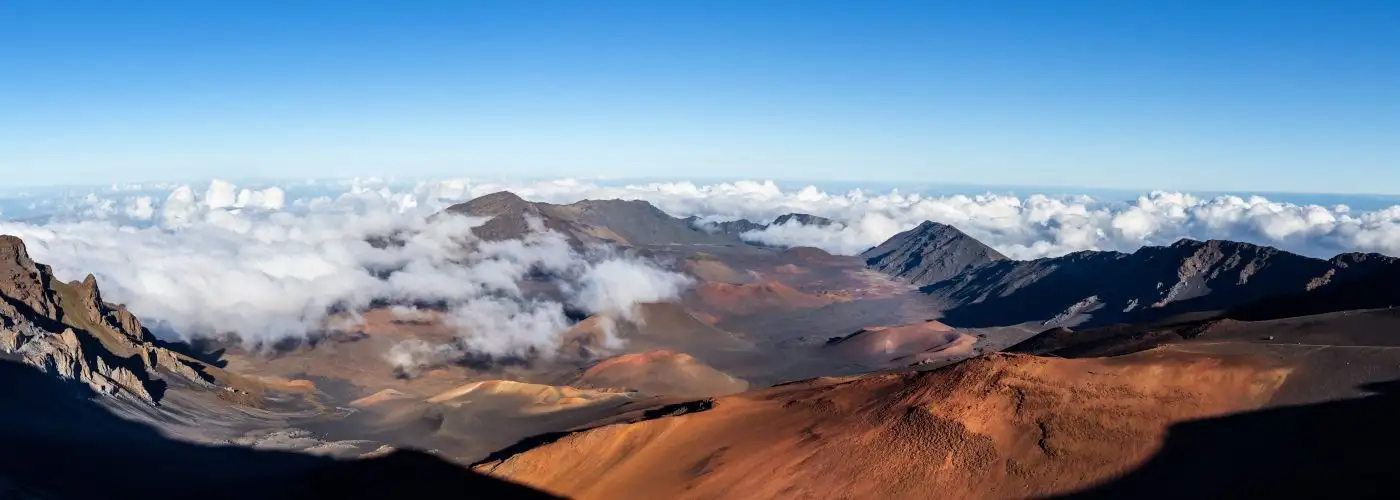The now-dormant volcano known as Haleakala has been sacred to native Hawaiians since ancient times, with its massive flanks covering nearly three-quarters of Maui and its 10,023-foot summit visible from almost anywhere on the island. Today, more than 33,000 acres of this volcanic mass is a national park that welcomes more than 1.2 million visitors a year.
Haleakala, which has been designated as an International Biosphere Reserve, is home to more endangered species than any other national park, including the native Hawaiian goose, or nene; the Hawaiian petrel; and the rare silversword, a distant relative of the sunflower found nowhere else in the world.
Driving the curving 38 miles from the park’s Pacific Coast to the rim of the crater will take you through as many eco-zones as a trip from Mexico to Canada—from lush waterfall-laced rainforest to cold subalpine desert. At any given moment, depending on whether you’re in the low-lying Kipahulu Valley or the volcano’s summit, you can be either splashing around natural pools in 80-degree sunshine or bundling up against the wind chill in sub-freezing temperatures.
While the Kipahulu Valley is a popular destination reached by the infamously windy Hana Highway, and the summit draws hundreds each day to watch the sun rise and set, relatively few people set foot at the bottom of the crater, which isn’t really a crater at all, but a depression carved out over millennia of erosion. Two hiking trails lead to the bottom, where lava-formed waves and spires envelop a landscape that scientists have measured as one of the quietest places in the world.
Why December Is the Perfect Time to Go
Because it’s December … and this is Hawaii! Traveling anywhere tropical during the last week in December—the holiday season—is a pricy proposition, and Hawaii is no exception. But if you can sneak away before the holiday vacations begin, accommodations will be relatively inexpensive and the crowds fewer.
In the coastal area of Kipahulu, daily temperatures are reliably 70-80 degrees year-round. However, weather conditions at the summit are always variable, even more so during winter, when a dusting of snow isn’t at all unusual. So if you plan to go to the top, just make sure to bring warm clothing, including rain gear. Since this is the wetter part of the year, vegetation will be at its lushest—including that harbinger of the holidays, the poinsettia, which grow to be eight-foot bushes in Hawaii!
Why It’s Great Other Times of Year
There are only two seasons in Hawaii, wet and dry, so deciding when to visit Haleakala really comes down to a matter of personal preference. Paradoxically, the most popular time of year to visit is during the rainy season, because even though it may be raining in Maui, it almost always beats winter on the mainland. The weather in mid-April through September is consistently dry and pleasant, though, and is also considered the low season, which translates to cheaper rates.
If You Go, Don’t Miss…
At 10,000 feet, the summit of Haleakala is well above the inversion layer that keeps clouds relatively low, so sunrise views here are reliably spectacular. Witnessing first light on Haleakala, described by Mark Twain as “the sublimest spectacle I ever witnessed,” has become one of the most popular tourist activities on the island.
December Bonus Pick: Biscayne National Park
This national park, south of Miami, is one of the least visited in the system—possibly because almost 95 percent of its 172,000 acres is underwater, half of which is home to one of the largest coral reef systems in the world. Biscayne National Park is a draw for sailors (the annual Columbus Day weekend regatta attracts hundreds of boats), snorkelers combing the reefs that teeming with sea life, and divers exploring one of the more than 40 documented shipwrecks within the park.
It’s also an important mangrove habitat, so reserve a canoe because December is prime time for manatee watching. But if the life aquatic isn’t your thing, there’s room for landlubbers, too: Both Elliot Key, the largest island in the park, and the more popular Boca Chita Key, with its historic just-for-show lighthouse, provide picnic areas and campgrounds. Wintertime is the best time to go, when the climate is mild and the mosquitoes are on the wane. Though there is a charge for the first-come, first-served camping, admission to the park is free year-round.
More from SmarterTravel:
- Zion National Park: Our November National Park of the Month
- Yosemite: Our October National Park of the Month
- Grand Canyon National Park: Our September National Park of the Month
We hand-pick everything we recommend and select items through testing and reviews. Some products are sent to us free of charge with no incentive to offer a favorable review. We offer our unbiased opinions and do not accept compensation to review products. All items are in stock and prices are accurate at the time of publication. If you buy something through our links, we may earn a commission.
Related
Top Fares From Columbus, OH
Today's Top Travel Deals
Brought to you by ShermansTravel
Shop and Save with Country Inns...
Patricia Magaña
 Hotel & Lodging Deals
Hotel & Lodging Deals
$229 -- Chicago: Discounted Rates and...
Francesca Miele
 Hotel & Lodging Deals
$229+
Hotel & Lodging Deals
$229+
$188 -- Honolulu: Save on Oceanview...
Abigail Lamay
 Hotel & Lodging Deals
$188+
Hotel & Lodging Deals
$188+




